One of the things that excited me the most about moving to Asia was the chance to experience and interact with a culture that had eluded me while exciting my imagination for years. While in college I studied English Literature but minored in Philosophy (80% of my hours were focused on Asian Phil.) and from both focuses I’d established a portion of my brain that would forever be dedicated to studying and wondering about Asia. I’ve always loved visiting Buddhist temples in the countries we visit as well as in Korea, but for some reason Stephanie and I’d never sat down to schedule a time to do an overnight Templestay. We’ve gone to several hanok villages and participated in several traditional activities, but the one most up my Asian Philosophy alley was never made a priority. Like many things that should happen, this got put off for later in the “of course we’ll do that” column. Recently, however, we were offered the opportunity to experience a Templestay here in Yeosu free of charge! The story and some pictures follow.
What is a Templestay?
Templestays are programs organized and promoted by Buddhist orders in Korea (there are more than several) to promote Korean Buddhism by simple allowing insight into customs and daily life of a monk. While on a Templestay you keep (loosely) the same schedule as a Buddhist monk living at a temple. You wake up at 3:30am for prayers and endless 108 bows, eat what the monks eat, wander the grounds in walking meditation, do activities like making lanterns or prayer beads, and have tea chats with monks. Obviously you aren’t required to do anything that makes you uncomfortable, but the program is designed to give you a taste of what Buddhist monks in Korea have been doing for hundreds of years. You wear special clothes, you’re supposed to walk a certain way, and they show you many of the customs in a very lighthearted and enjoyable way. Buddhists aren’t known for their severity and we were constantly being told that if any activity was too much to handle or we weren’t interested, we were free to step out.
The Story: Day One
Intro into Becoming Monks
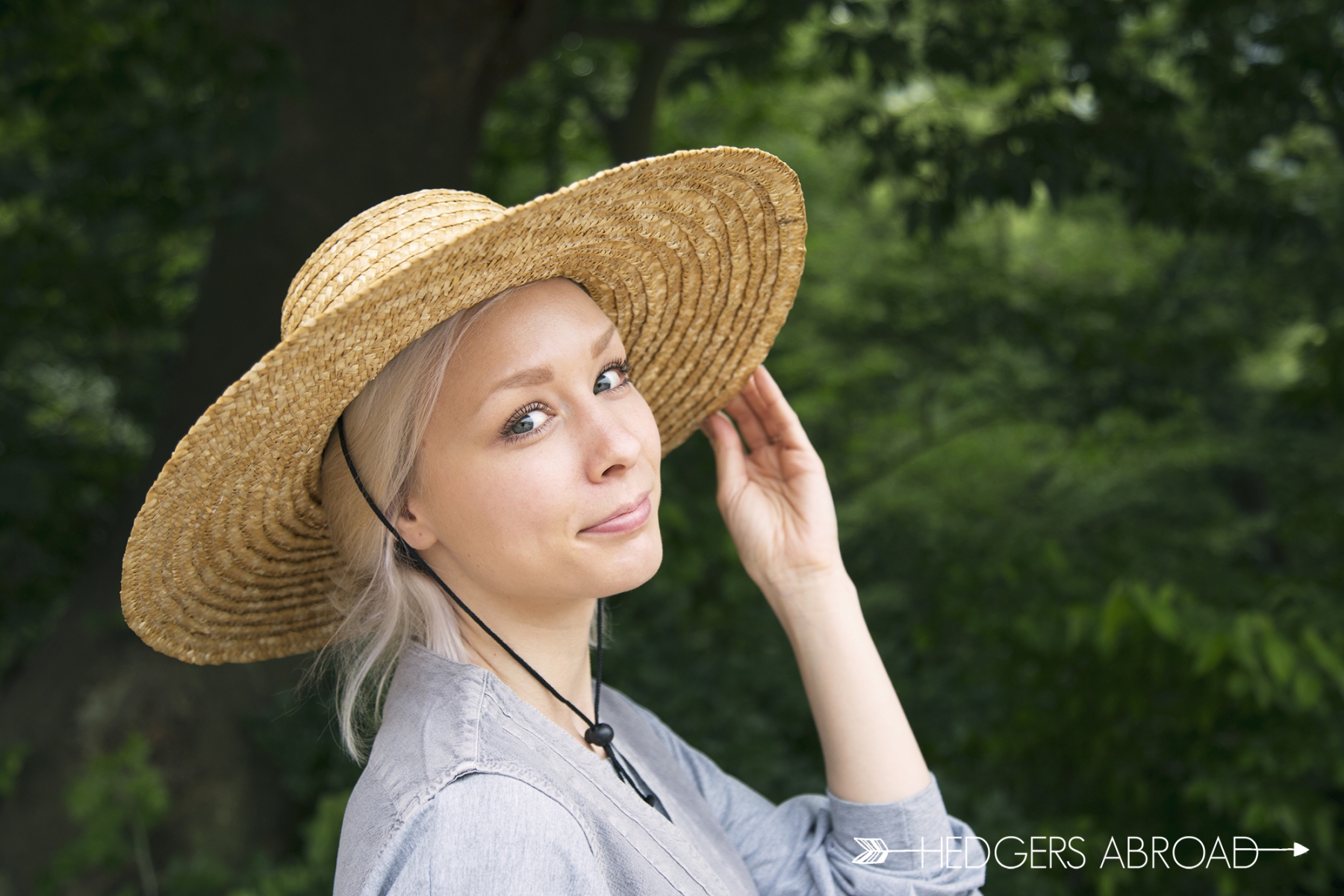
Arriving just after lunch we were actually earlier than the rest of our party, but the schedule allowed for such eventualities. We read some of the introductory material after being given our rooms before we began the tour of the temple and brief description of the history of Heungguk Temple. This temple has a long history spanning hundreds of years. We were surprised by some of the things we heard about Korean monks fighting the Japanese to protect their community (non-violence being a pretty big deal in Buddhism) and ultimately dying after they realized their inadequacies as warriors…
- Our little abode for the night
- All the monks
- Temple Tour
Tea Time
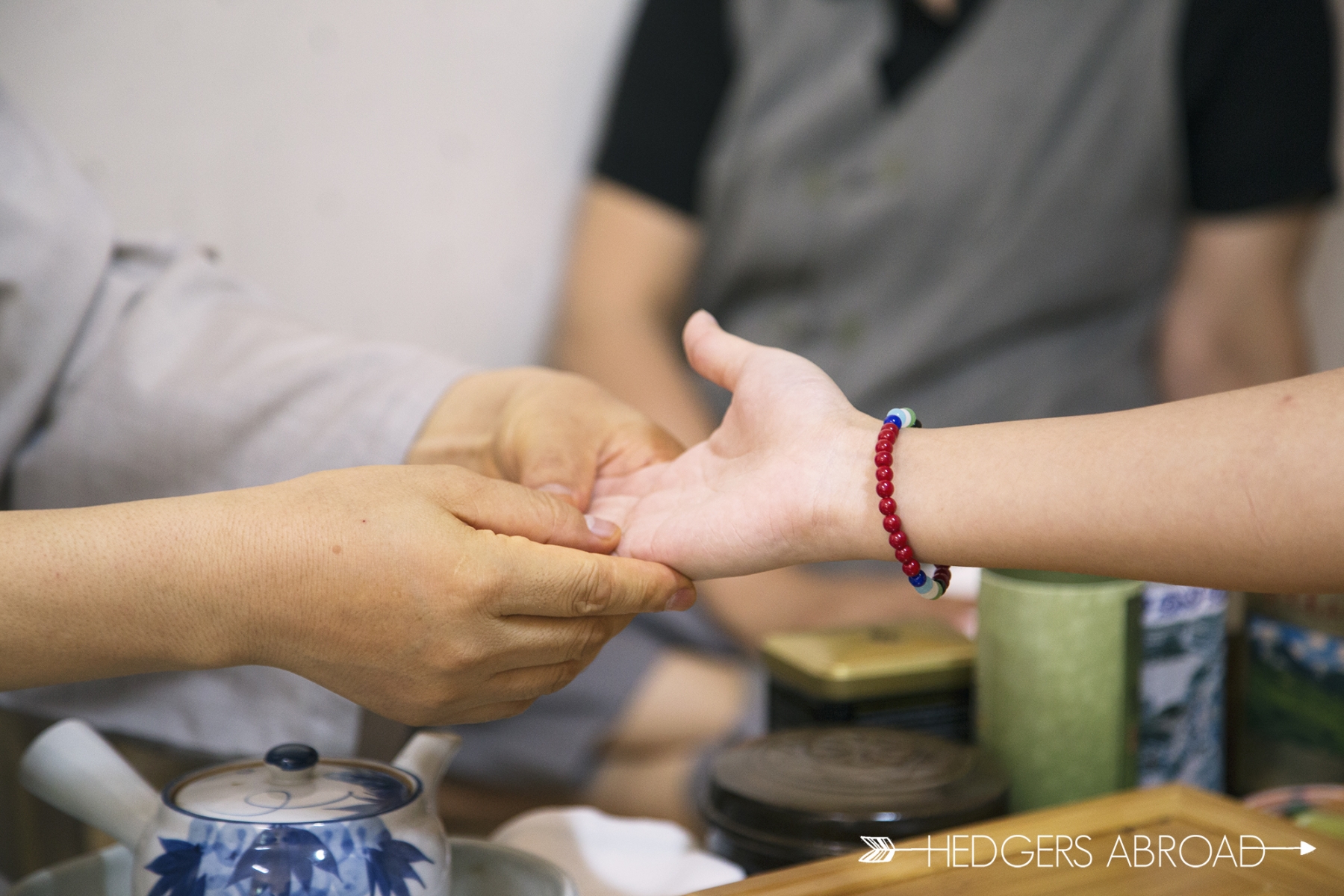
Leaving the small museum and history lesson we walked the grounds with our English speaking guide for quite some time discussing various topics with both parties (guide and visitor) asking questions. After some time we were given leave to “take a rest” before we had tea with one of the monks. During tea we had our palms read by a monk who was obviously into some metaphysical aspects of Buddhist curiosity. From our palms, the monk was able to tell us that I was a woman in a previous life and that Stephanie was a man. After this revelation he went on to describe our personalities and dispositions pretty well, so he might have been right about the first part as well. Who knows? The only part that got me was the translator emphasizing “you’re very feminine” to drive the point home. I hope that she got some verbage wrong and was meaning to describe my past life, but she was pretty absolute. That’s all about that.
108 Bows
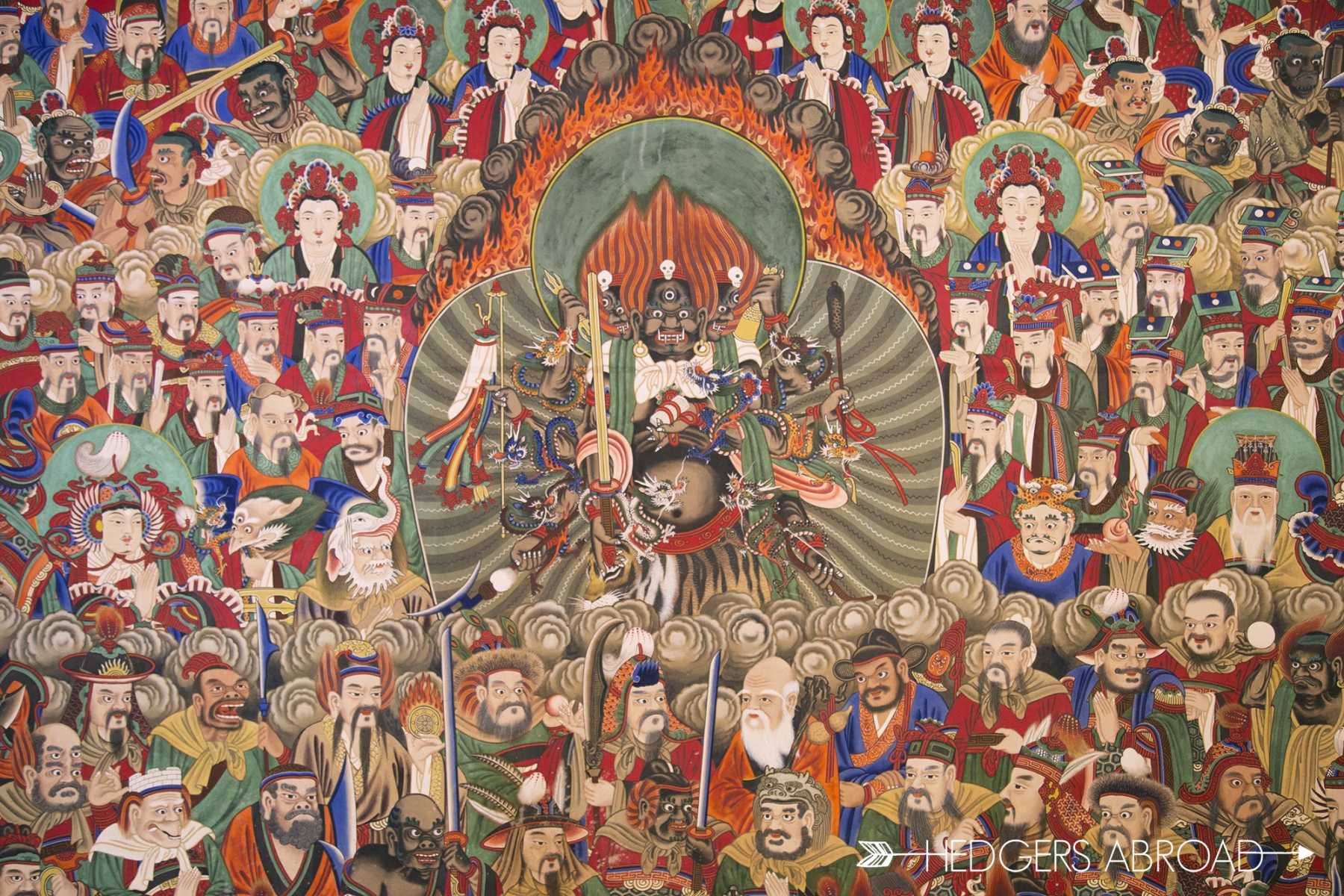
Later that night, and after a delicious meal, we were lead to our evening prayer ceremony where we got our first real taste of Buddhist duty. We’d been taught previously how to bow properly in several ways, and it was time to perform 108 prostrations during an actual evening ceremony. After studying and researching Buddhism for year, I knew that those extra eight were added on to allow for a few mistakes and imperfect mantras/bows, so we all went full bore and attempted the whole number to make sure we got the hundred right. During these seemingly endless bows we all got a little lost. We didn’t know how far we’d come, how long we’d been going up and down, how much time had elapsed, or if the Buddha really even wanted us to do so many in his honor. In my mind, it was an interesting conflict between the Buddhist philosophy and subsequent religious practice. While I lean more toward enjoying the philosophy, the practice was both enjoyable and exhausting: proving that any sort of dedication required sacrifice. No casual Buddhists were spared in those 108 fast-paced prostrations.
Lantern Making
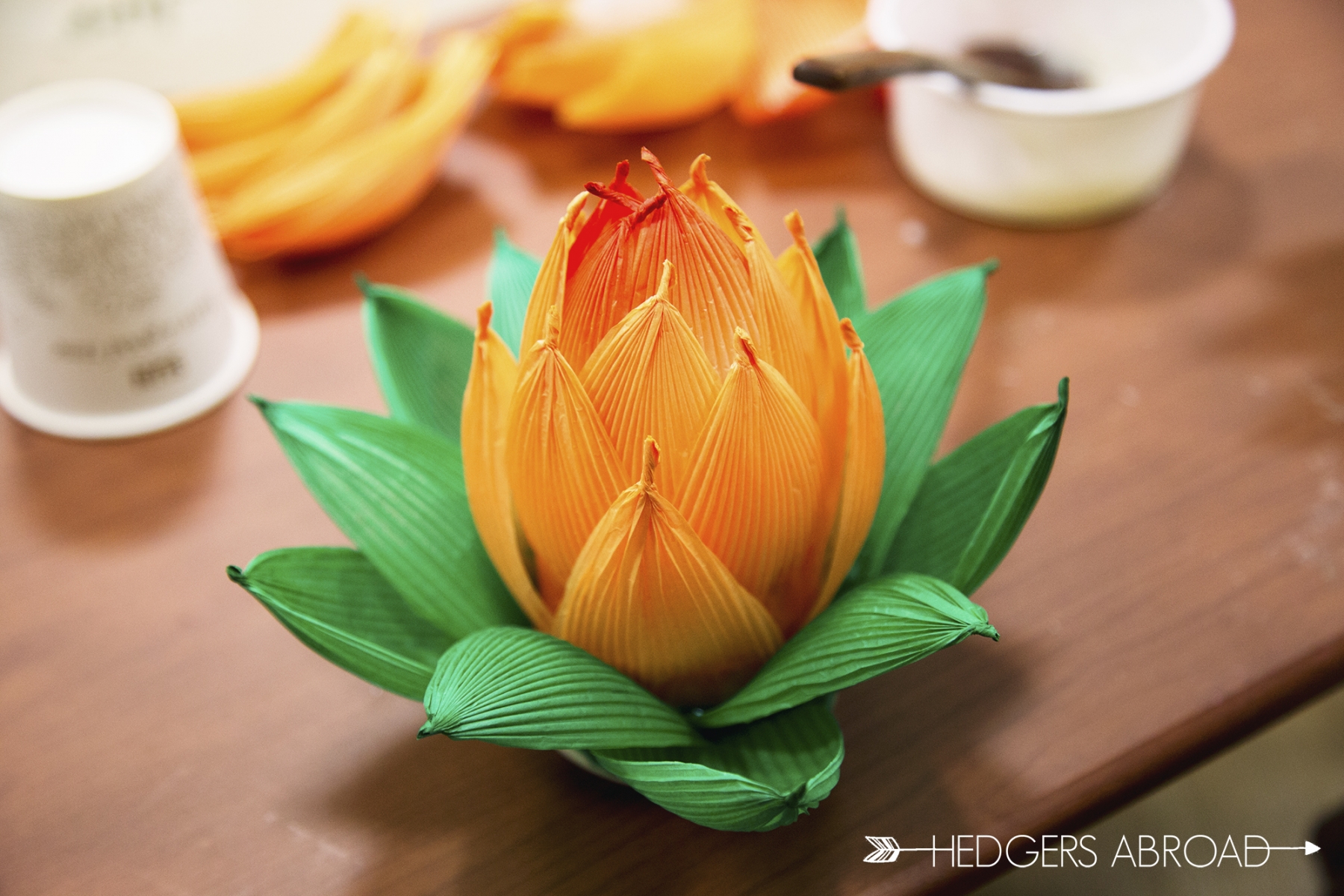
After bowing endlessly, we were given time to go shower (we needed it) and regroup before making lanterns. This is where the experience got weird. The monk joined us and we started making the lotus lanterns that we would use the next day for earning Buddha’s favor and granting wishes, but this isn’t what stands out. While we’d all had been bemused by the life-predictions of the tea ceremony earlier, the lantern-making time proved even more interesting. The monk, we can only assume after living a celibate life of duty and servitude, started harping on the themes he thought we’d be most interested in and began explaining his thoughts on sexuality and monetary gains. To avoid details, I’ll summarize: have lots of sex to avoid stress, and be well-liked and popular if you want money. Totally not what we expected to hear from a monk, since all of these considerations were supposed to be beyond his realm of attention.
- Lantern time! Think of your wish…
- Lantern time!
Day Two
3:30am Wake Up Call
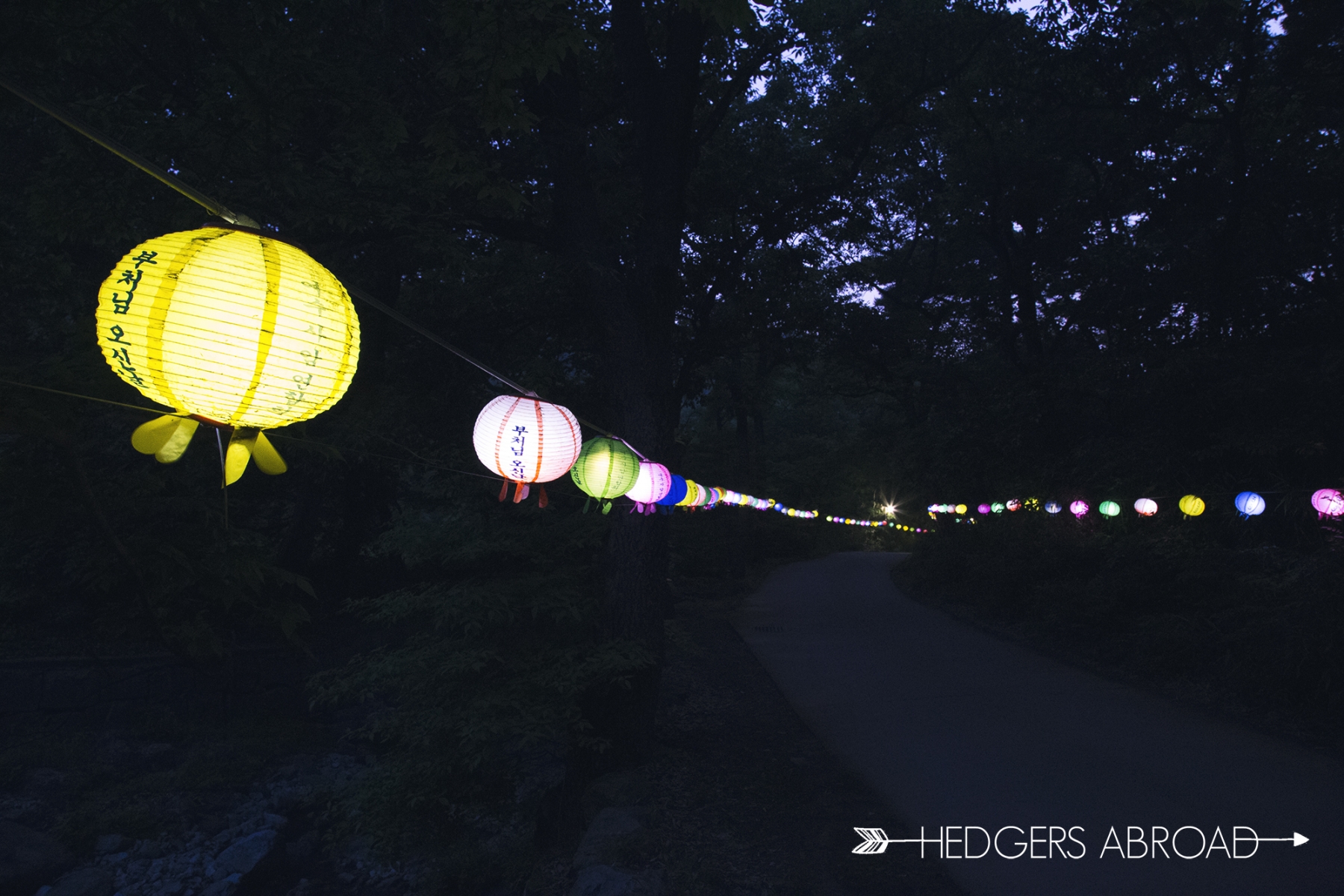
The next morning we bolted out of bed at the ripe time of 3:45am. The youngest monk in residence of Heungguksa Temple was tasked with marching through the temple grounds banging a wooden bell to gently wake up the residents before the 4am giant bell began to toll. Groggy, and barely remembering to bring our lotus flowers from the night before, we stumbled and rushed to the prayer hall for the morning bowing and chanting ceremony. Barely realizing/accepting that we were in store for another 108 prostrations, we trudged. Mats laid out before us, we started our half-bows and full bows in following the lead of the monks ahead of us. With a slight sweat starting to bubble, our monk suddenly called the ceremony off after bowing several time to the Buddha paintings on the left-wall. Looking back, I think he assumed that we wouldn’t want to repeat our previous 108 and decided our time was better spent. He lead us to a different temple honoring the Boddhisatva where we were supposed to ask that our prayers be answered with another three full bows. Confused, we exited and were lead back to our rooms where we were allowed to sleep until breakfast. This isn’t typical of Templestay programs, in that you’re typically expected to repeat the 108 bows in the morning, and you finish just in time for breakfast (without additional sleep).
Hiking (in the Rain)
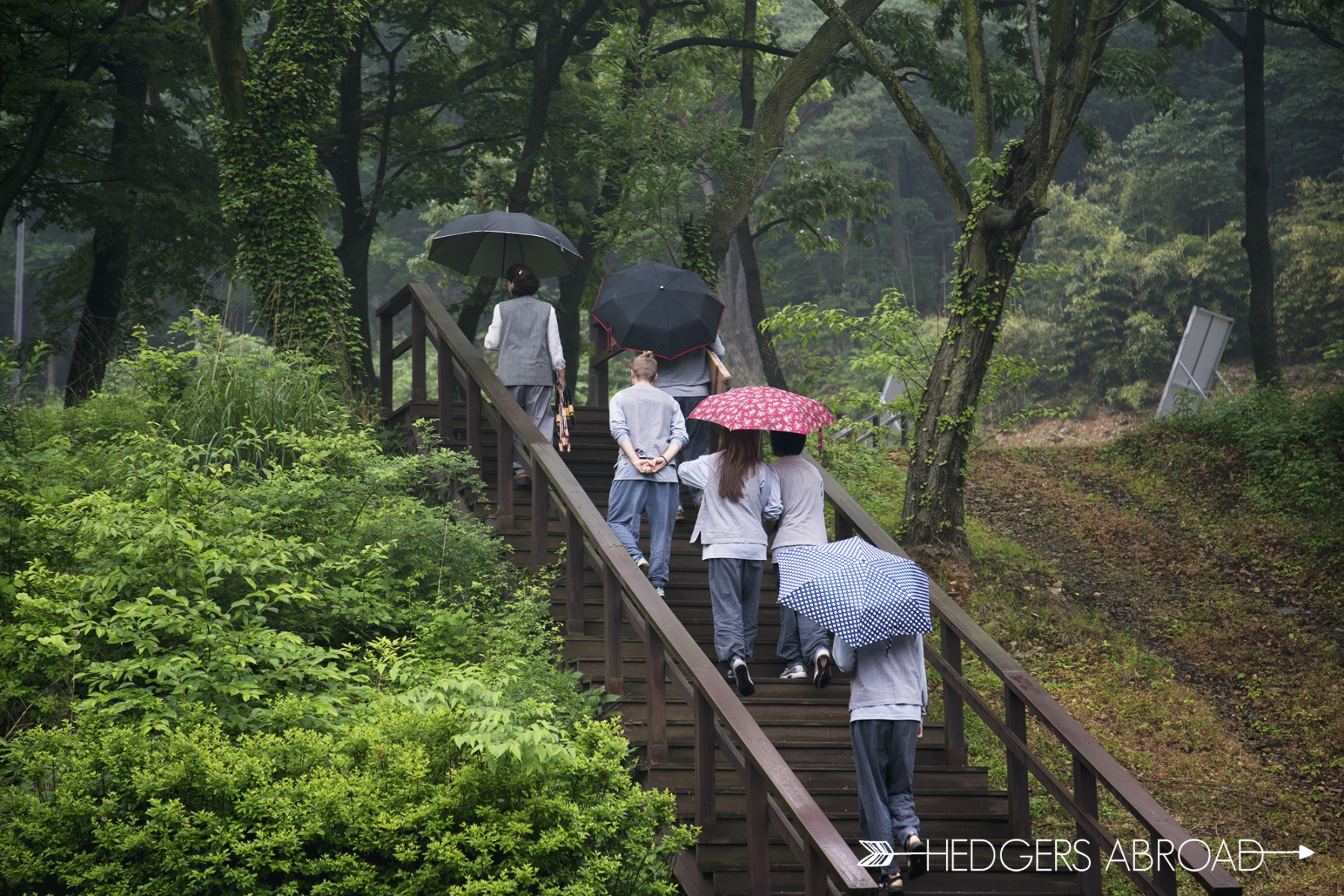
For breakfast an hour later, we were surprised by inclement weather and a damper on the day’s schedule. More tired than before, we awoke for a breakfast of vegetables and rice. Breaking our fast with the monks and our fellow Templestay friends, we realized that our morning would be changed by the weather. In Buddhist fashion, we went with the reality of things and accepted whatever plan our translator formulated in the moment as our reality. She decided that, despite the rain, we’d go ahead with our morning hike up the mountain. We weren’t able to sit and meditate on the rocks like the monk hoped since everything was soaked, but we, instead, made our way back to the temple while being shown magic tricks (I’m talking “pull your thumb off” tricks) from the monk while we hilariously continued back to home.
- Karins (doltop) – For luck and granting wishes
- “How culty does it look?!”
Becoming Actual Warrior Monks (Archery)
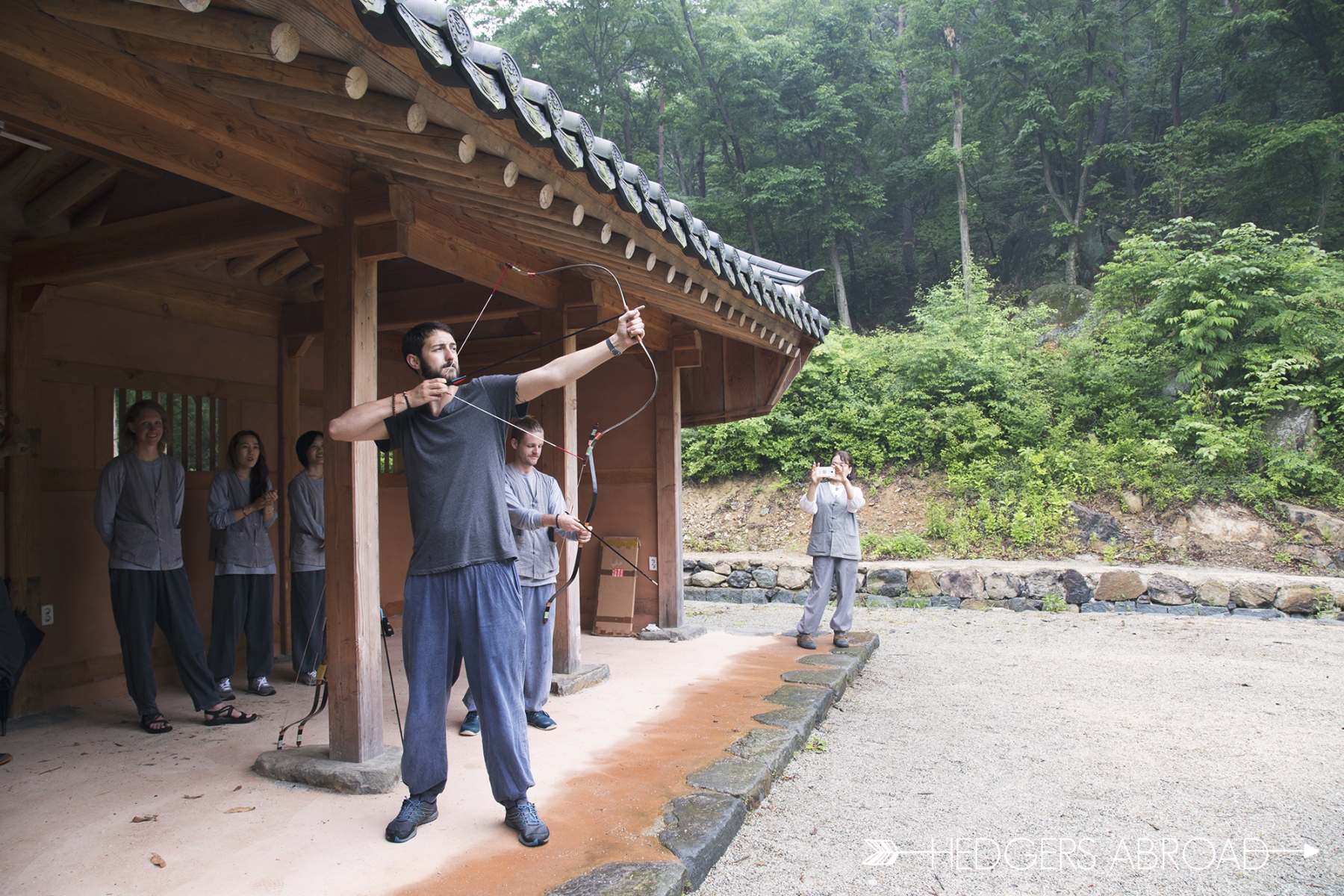
Back at the temple we had another tea time with our translator. She’d found out that the monk had given explicit and extensive sexual advice and proceeded to give numerous apologies and explanations that the monk wasn’t the typical one used for Templestays, but had been used in duress as a replacement. We spent the hour of tea and fruit confirming to our translator that we weren’t upset, as she’d found out about his discussion topics. After this, we were back to enjoying our stay and dialogue with our translator. We waited for a while after the tea before heading up the nearby hill to practice archery. Since our monk-forefathers were famously slaughtered defending Yeosu, we thought it appropriate to practice our weapons. We had a lot of fun firing arrows down range but few found their target. We realized quickly that we wouldn’t have been much more help than the original monks against an invading army.
The Quintessential “Chill” Session
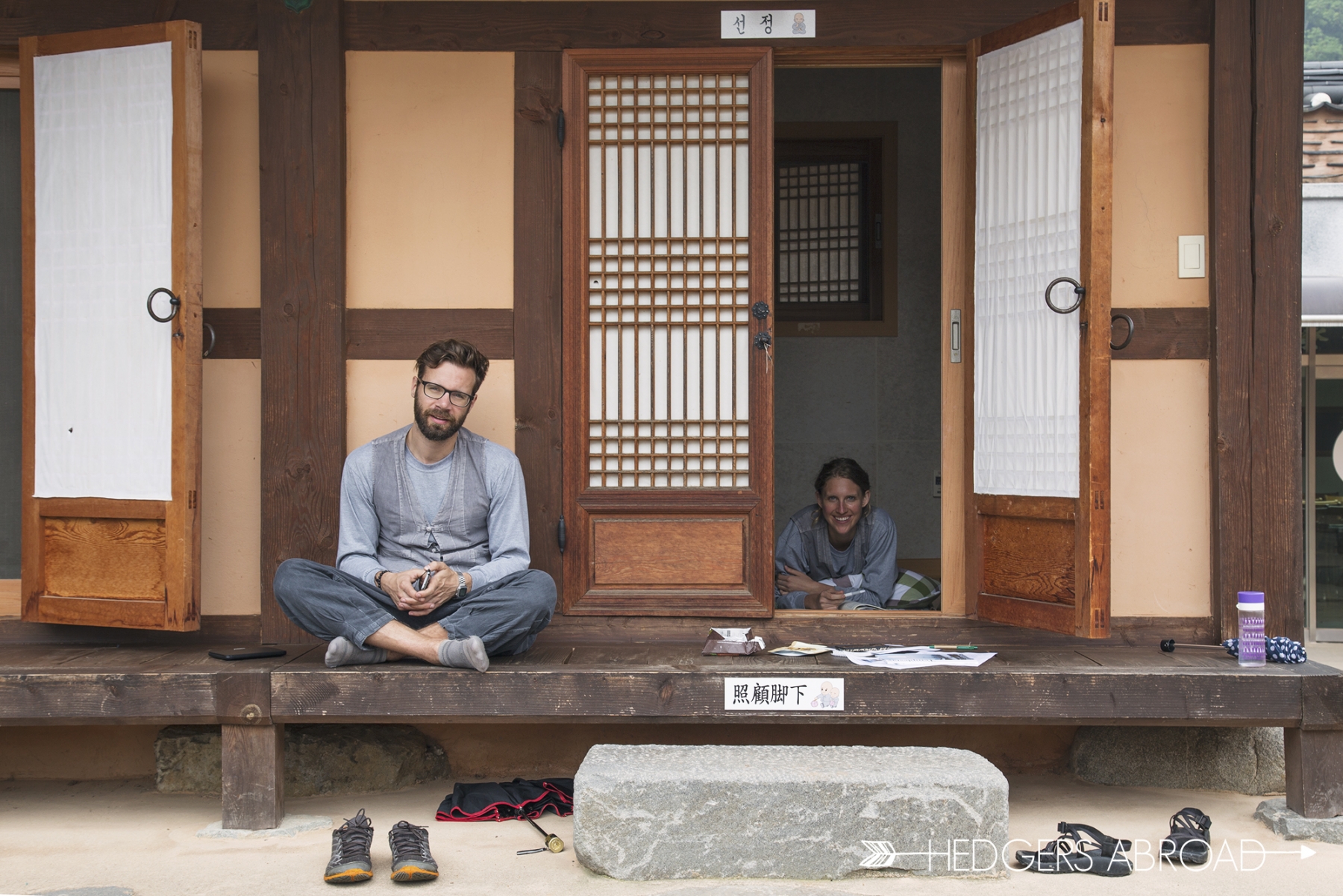
The rain resumed and we returned to our porches to read and recount our experiences. Around noon we went to lunch and had a similar meal to the two before. We stuffed ourselves with rice and vegetables hoping to compensate for the hours of sleep lost, but ended up really loving the meal like we had the ones previous. At this point, we were released. Strangely unwilling to leave in such a way, we lounged about a bit more before leaving our buildings’ porches and the temple grounds.
Afterwards
With new levels of relaxation achieved and a new sense of appreciation for Korean culture, we left Heungguksa for our car. Along the way we were pleasantly surprised to find food and booze tents provided for mountain hikers and quickly made a group decision with our friends John, Mara, and Mark to stop for a bite to eat and some rice wine. As we sat along the river drinking makgeolli and eating kimchijeon, we reflected on our experience and felt a collective joy in the strange but still-relaxing experience we’d all had. While the monk had surprised us with non-traditional and probably controversial Buddhist wisdom, we took his advice and future-telling with a grain of salt, instead focusing on the relaxing and meditative times we spent entranced by the sound of rain streaming off of the roofs and the peaceful walks we’d enjoyed.
Templestay Programs in Korea
Although we waited a long time after arriving in Korea to finally do a Templestay, we’re already thinking that we’d like to do another later this year. Hopefully next time we can be a little bit more focused and better appreciate some of the aspects we’d not understood during our first experience. For anyone looking to attend a Templestay of your own, check out the Templestay website or contact your local temple to see if they offer such services. The website is totally in English and there are tons of temples to choose from.
Near vs Far
Keep in mind which temple is best suited for you. A temple in the heart of Seoul may be the most convenient, but I will guarantee you that it is not going to be the most relaxing thing you’ve ever done. Relaxation was the best thing that came out of the templestay for the both of us and we wouldn’t have traded that for anything. We had friends who booked their templestay only to have it completely ruined by a nearby K-Pop concert!
English Translators
The temples on the templestay website will also all offer some sort of English translator as these programs are meant to give foreigners a glimpse into Korean culture and Buddhism. Our translator stayed in contact with us via email throughout the preceding weeks and answered all of our questions as well as prepared us for what programs we would be attending. Afterwards, she asked for our phone numbers and sent us photos that she had taken throughout our stay.
What to Bring
What to bring is totally up to you, but here’s what we brought. We both took only one change of clothes since we knew the temple would be giving us some grey monk outfits. We took a good pair of walking/hiking shoes because most templestay programs will have you walking or doing some sort of hiking meditation. Toiletries and towels were also packed as well as some camera equipment and reading material. The temple was well suited to our needs and had bedding, showers, modern toilets, food, and even air conditioning and TV! It is only a one night program, and you really should try to unplug as much as possible, so try not to bring too much stuff!
If you have any further questions, be sure to let us know in the comments below and we will do our best to get back to you asap!

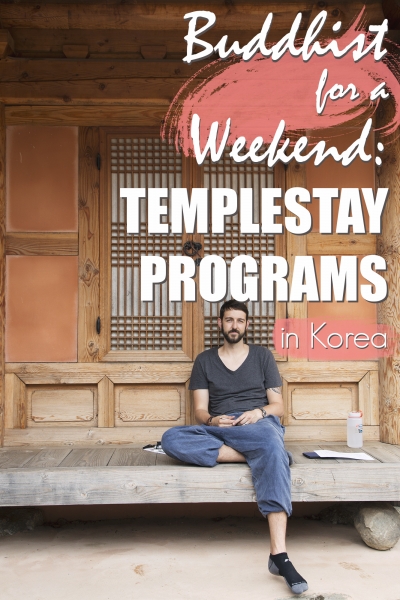

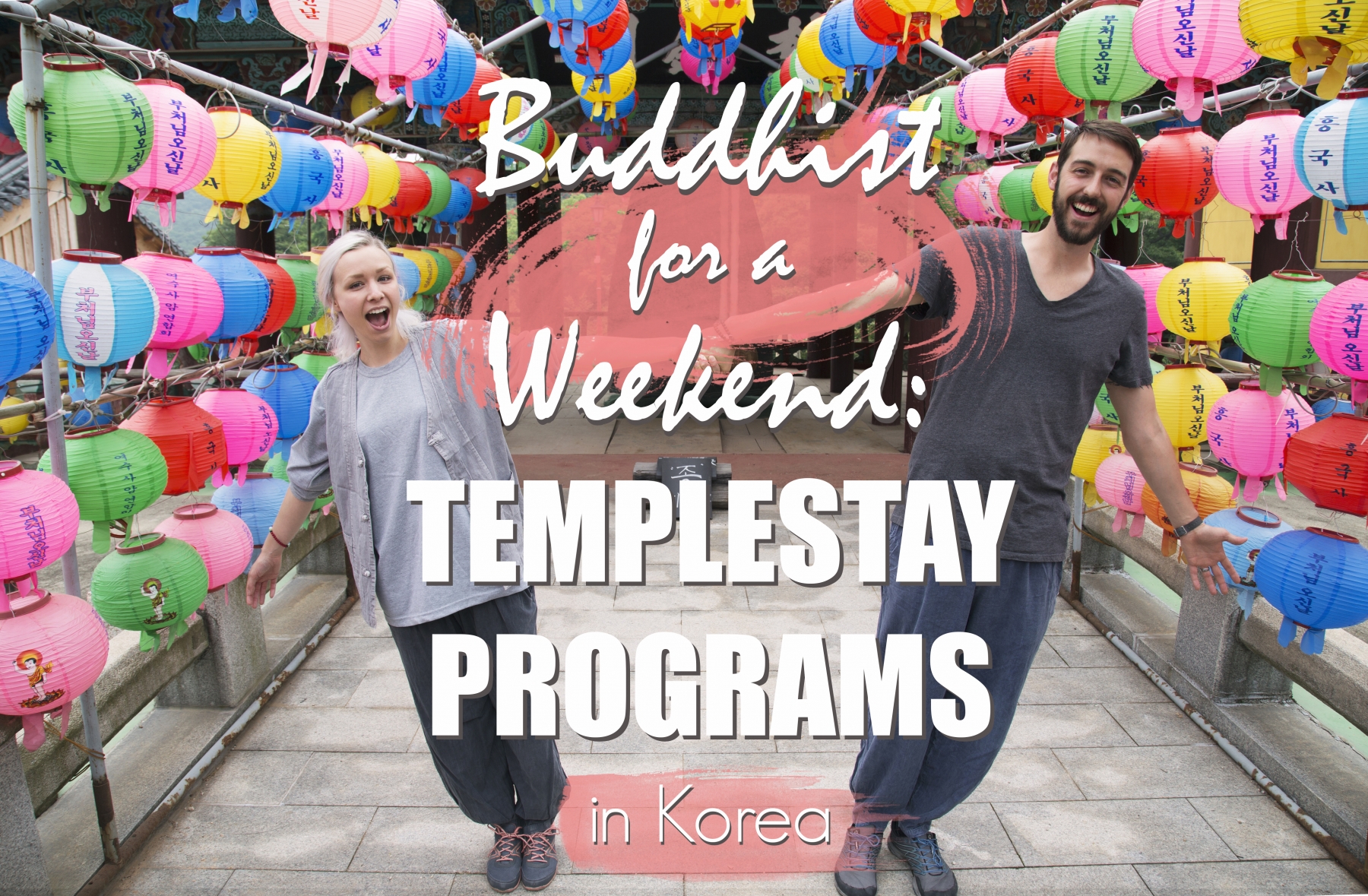
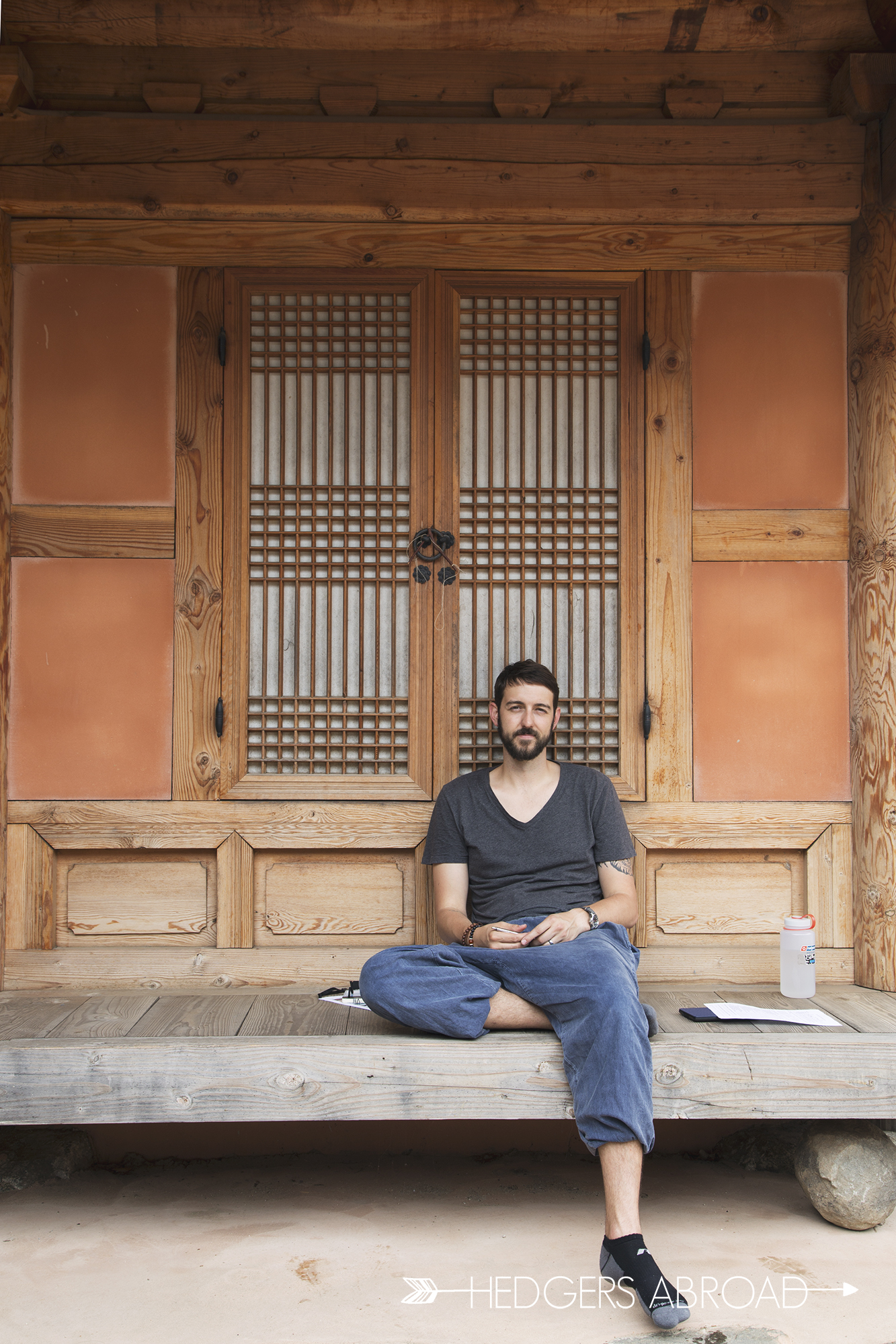












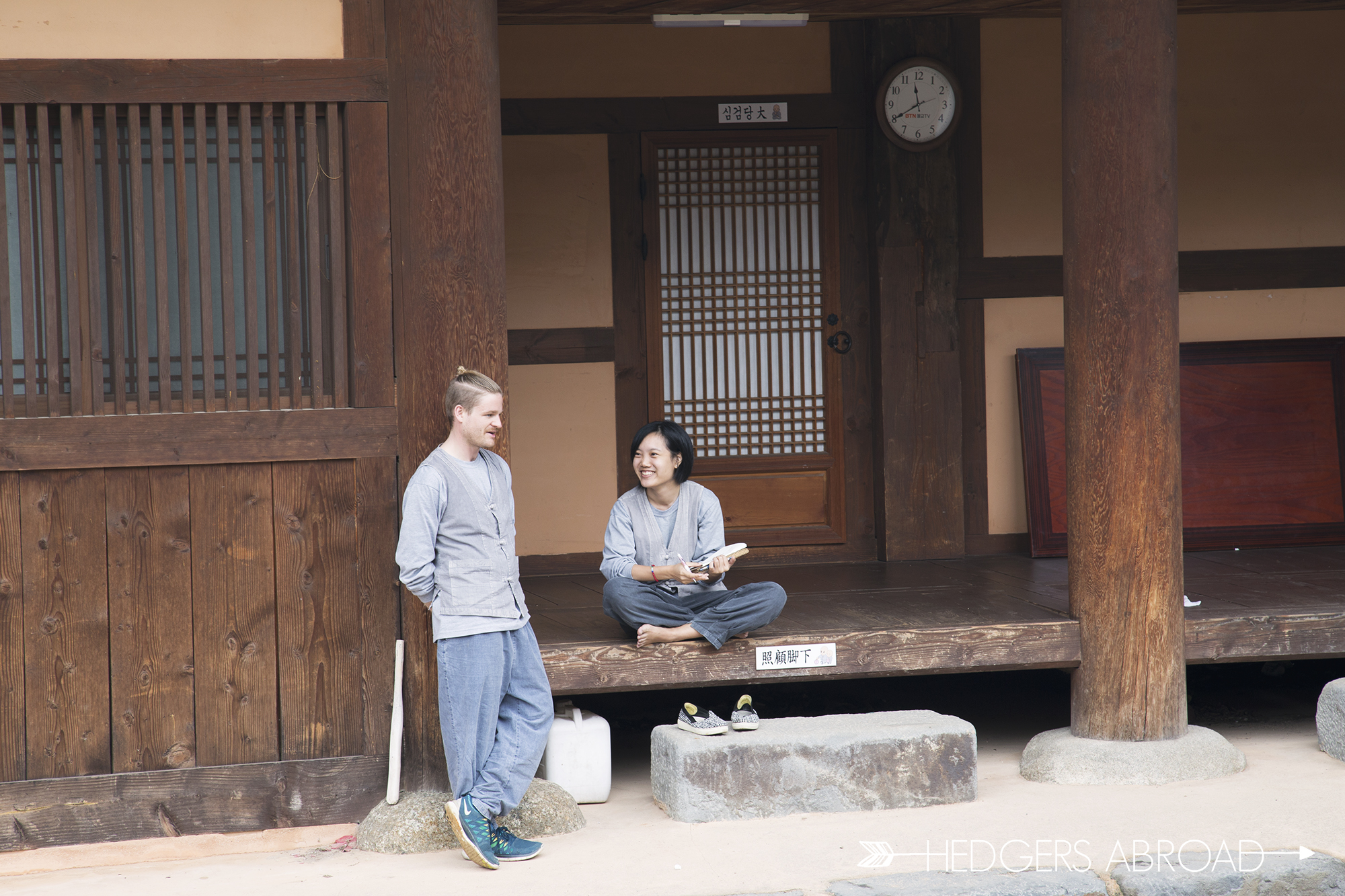


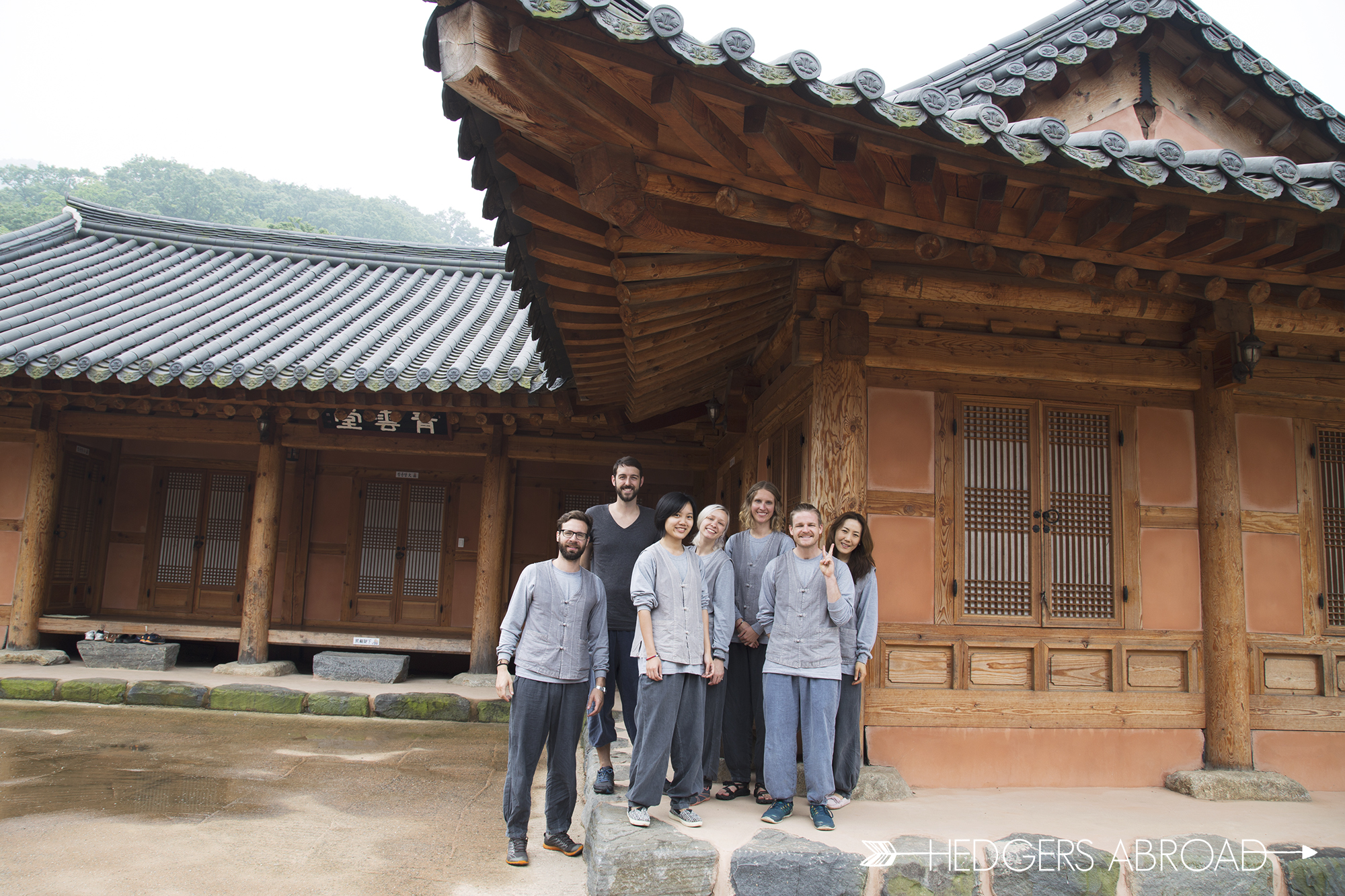
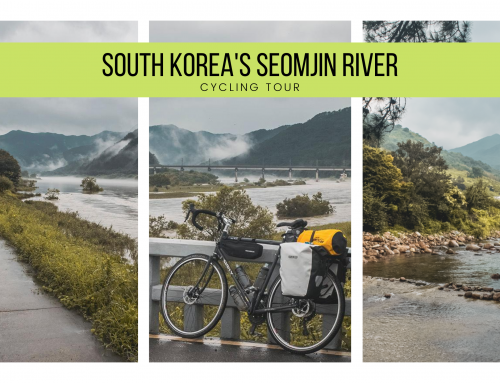
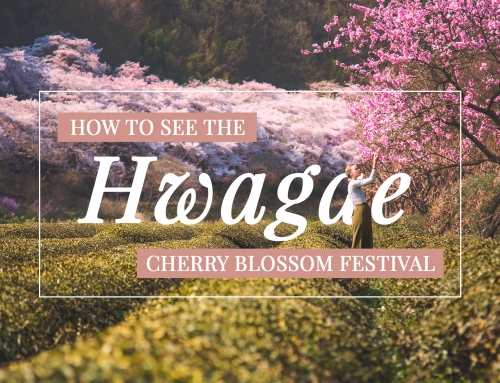
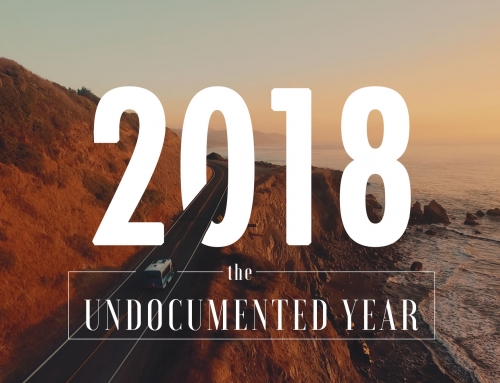


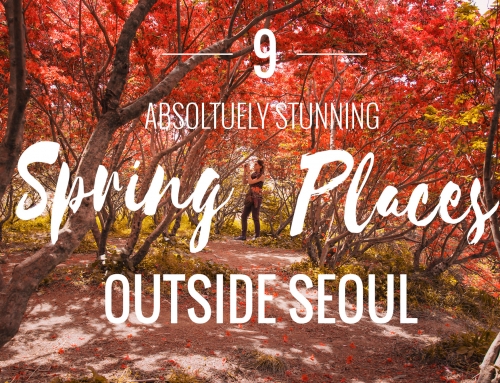
This is something I’m really hoping to do once I get to Korea! Thanks so much for posting this guys. I will ‘pin it’ for later to refer to when it comes time to book my own temple stay. I love all the Korea-specific content you guys post on your blog – it has been so useful for my upcoming move there! 🙂
Thank you so much, Katherine! We are glad that you found this post and it’s inspired you. When we were planning to move we devoured blogs and videos in preparation, and now we get to share in much the same way! When will you be moving to Korea, by the way?
Hey guys! We are planning our move for the beginning of August. Can’t wait!! 🙂
How exciting! Do you know where you’ll be living and what type of jobs you’ll have?
Great photos and awesome write up guys! You guys look awesome in your little monk outfits! Haha, and our k-pop concert wasn’t nearby during our templestay it was happening AT THE TEMPLE! hahahaha how absurd right? You guys are making us want to give a temple stay a second chance! We agree that you need to get out of the city to have a better experience, especially when almost all the temples are located on beautiful mountains!
Oh you guys should absolutely give it another go outside of the big city. Many temples, like the one we went to, are unofficially part of the Templestay network and can’t be found on the site. I think that’s why ours was free: they need feedback and reviews to submit in their “put us on the main site” application. And I forgot that your KPop experience was IN the temple. That’s just absurd. We had a little bit different music consisting primarily of gongs and bells, and probably less distracting.
[…] agree that we all have our own path to that realization. Recently we published a post about our Templestay at Heungguksa, a Buddhist temple here in Yeosu. We were given insight into the daily practices of a typical monk […]